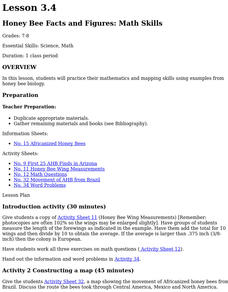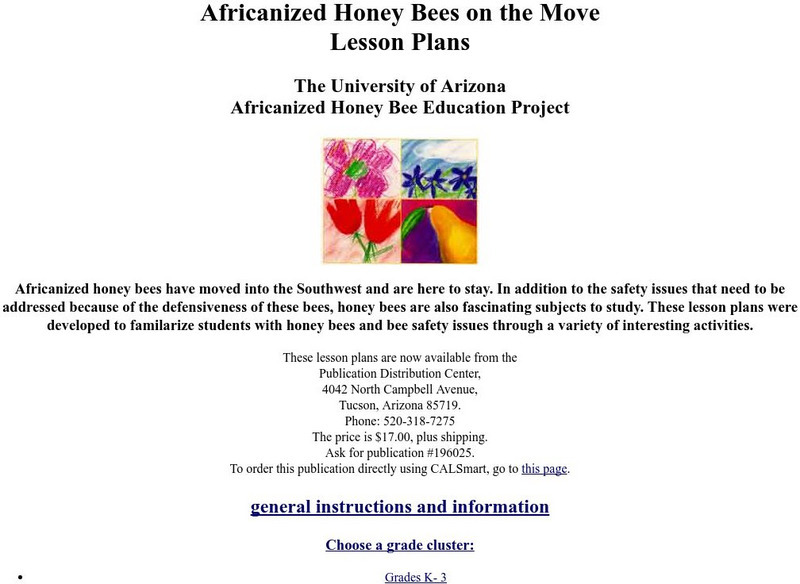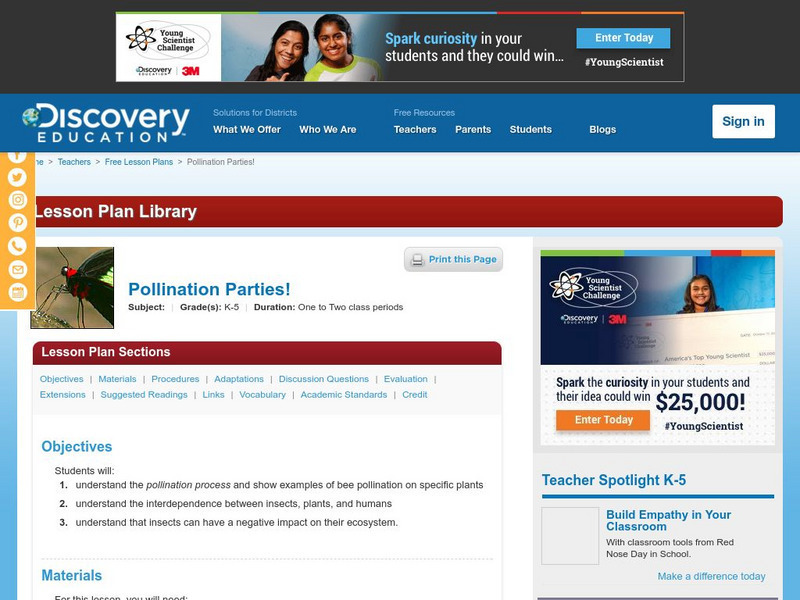Curated OER
Honey Bee Biology
Students review the basic parts of an insect and explore the anatomical characteristics of a honey bee. The second part of the lesson focuses on ways to identify a honey bee from other stinging insects.
Curated OER
Honey Bee Facts And Figures: Math Skills
Students practice their mathematics and mapping skills using examples from honey bee biology. Discuss why the colonies were found in this pattern. They examine food and water in the area, and how many humans live in the area where...
Curated OER
Honey Bee Language Arts And Literature
Students see how nature and honey bees are presented in literature. They find and read poetry that include references to bees. Have them write their own poetry or Haiku.
Curated OER
Honeybee
Students investigate honeybees and the importance of honeybees to humans. They identify the various parts of a bee's body using velcro parts, role-play a hive, and answer review questions.
Curated OER
Biology Tessellations
Students review three types of polygons that are triangles, squares, and hexagons. They use a computer program to draw various types of tessellations. The students use the drawing of a honeybee as inspiration.
Curated OER
Communication in Bees
Eighth graders identify and interpret a scientific investigation and a hypothesis through experimentation and testing a hypothesis. They identify what scientists hypothesized about the communication of stingless bees. Finally, 8th...
Curated OER
Who Wants to be a Millionaire? Human Body Systems and Plants
Fifteen multiple choice questions review a variety of biology topics. In game-show fashion, viewers answer questions about a plant's needs, the skeletal system, and the cardiovascular system. If you happen to teach these three topics...
Curated OER
Insects!
Students explore the diet of insects. In this "insects" biology lesson, students take a nature walk and collect various natural materials they think may be eaten by insects. Students sort and classify these materials into three diet...
Teacher Writing Center
Spring Lesson
Ring in the spring with a study of adverbs. These spring worksheets cover when and how to use adverbs, provide plenty of adverbs to try out, and use images of spring as inspiration for students to tap into as they write original sentences.
Curated OER
What's in a Name?
Students study the binomial system of naming organisms. They are given a name of an organism and they must draw a picture of what they think the organism looks like. Then they research the organism, find what it really looks like, and...
Curated OER
Insects Are Helpful!
Students see that insects do lots good and are very valuable to humans and nature. This is part of an ongoing effort to dispel fears of insects. They rotate through a series of centers that have examples of how insects contribute to our...
San Diego Zoo Global
San Diego Zoo: Kids: Bee
Bees fly from flower to flower, sipping nectar and collecting grains of pollen. Bees have a special tongue that sucks up the nectar and a crop in their throat for storing it until they get back to the hive, where it is turned into honey...
University of Arizona
University of Arizona: Africanized Honey Bees on the Move
This is a lesson plan for grades 9 - 12. There are worksheets that can be printed out. Each activity and objective is stated.
BiologyWise
Biology Wise: Emergent Properties That Exist in Biology
An explanation of the concept of emergence and what it means in biology. Emergence is a property of a system or structure that is present in the whole but not in its individual components. Presents examples of emergence at different...
BiologyWise
Biology Wise: Understanding Batesian Mimicry
Biological mimicry is a fascinating subject and Batesian mimicry does not disappoint. It occurs as a protective mechanism when one defenseless species mimics characteristics of a species that can harm or even poison a predator. Examples...
NC State University
Beekeeping Insect Note: Cucumber Pollination
How many bees do you need to pollinate cucumbers? How do you maintain the hives? Answers to these questions and more.
Discovery Education
Discovery Education: Pollination Parties
This lesson helps students understand the concept of pollination. Objectives, materials, procedures, adaptations, discussion questions, evaluation, extensions, suggested readings, links, vocabulary, and academic standards are all included!
Other
Maarec: The Colony and Its Organization
Find out about the group behavior of bees in a colony.














